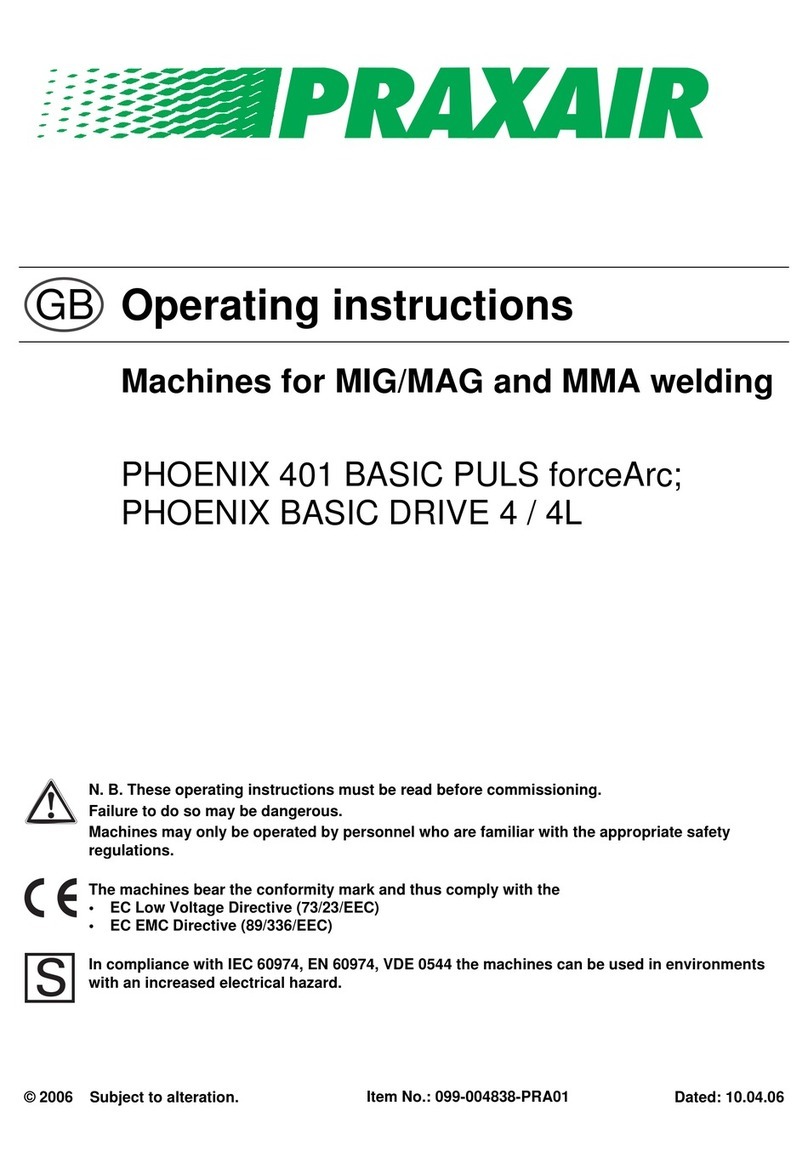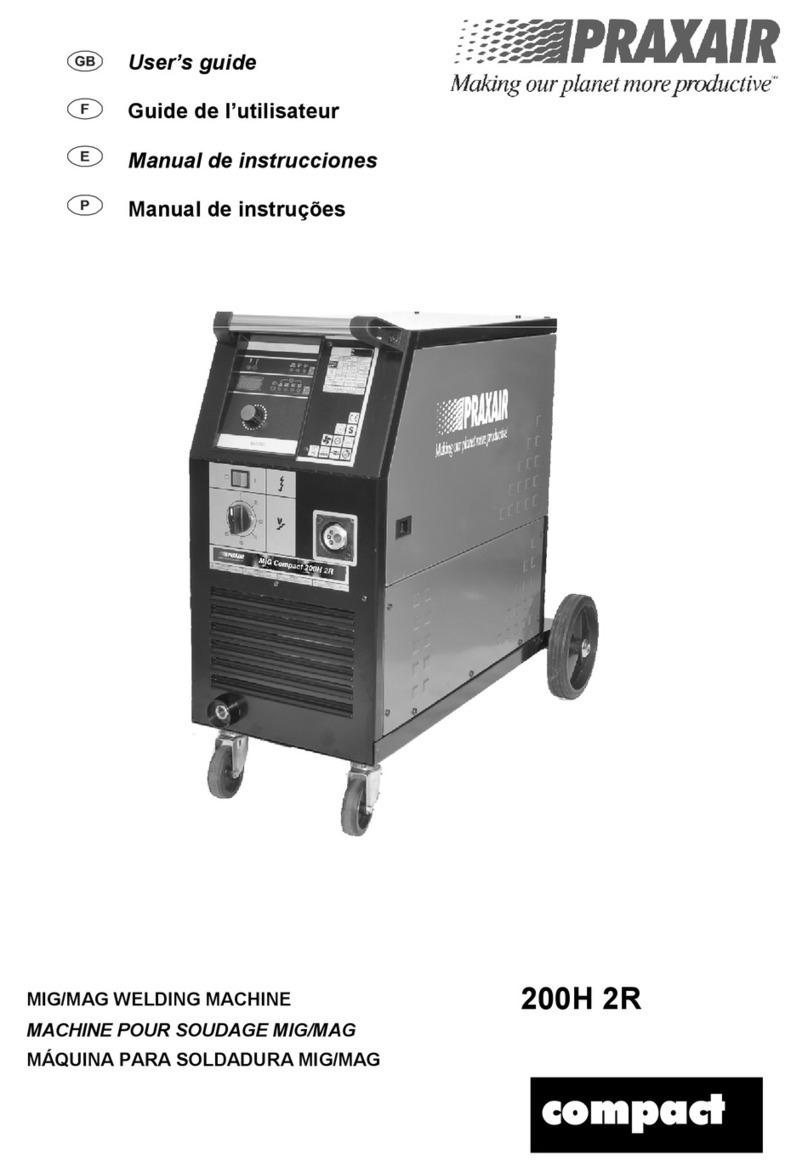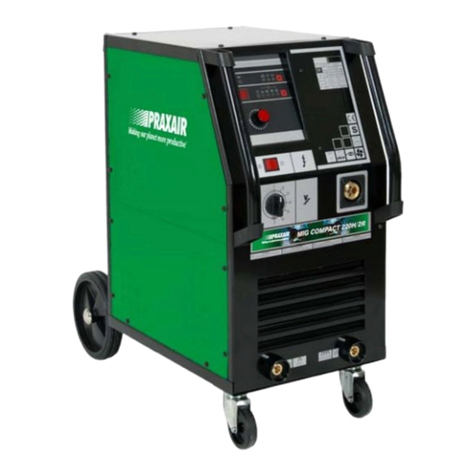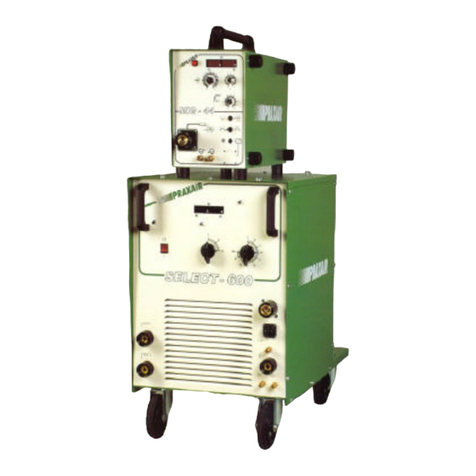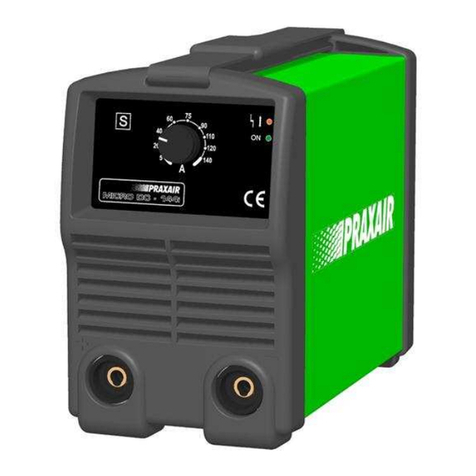
MICROTIG AC/DC 202 PULSE
5
1.1 ELECTROMAGNETIC COMPATIBILITY
The user is responsible for installing and using the arc welding equipment according to the manufacturer’s instructions. If electromagnetic
disturbances are detected, then it shall be the responsibility of the user of the arc welding equipment to resolve the situation with the technical
assistance of the manufacturer. In some cases, this action may be as simple as connecting to earth the welding circuit. In other cases, it could
involve constructing electromagnetic screens enclosing the welding power source and the work complete with associated input filters. In all cases,
electromagnetic disturbances shall be reduced to the minimum to avoid troubles.
Before installing arc welding equipment, the user shall assess potential electromagnetic problems in the surrounding area. The following
shall be considered:
a) Supply cables, control cables, signalling and telephone cables, above, below and adjacent to the arc welding equipment;
b) Radio and television transmitters and receivers;
c) Computer and other control equipment;
d) Safety critical equipment, e.g. guarding of industrial equipment;
e) The health of the people around, e.g. the use of pacemakers and hearing aids;
f) Equipment used for calibration or measurement;
g) The immunity of other equipment in the environment. The user shall ensure that other equipment being used in the environment is compatible.
This may require additional protection measures;
h) The hour of day when welding or other activities are to be carried out.
1.1.1 Methods of reducing emissions
Connection to mains
Arc welding equipment should be connected to the input supply system according to the manufacturer’s recommendations. If interference
occurs, it may be necessary to take additional precautions such as filtering of the supply system. Consideration should be given to shielding the
supply cable of permanently installed arc welding equipment, in metallic conduit or equivalent. Shielding should be electrically continuous throughout
its length. The shielding should be connected to the welding power source so that good electrical contact is maintained between the conduit and the
welding power source enclosure.
Welding cables
The welding cables should be kept as short as possible and should be positioned close together, running at or close to the floor level.
Equipotent bonding
Bonding of all metallic components in the welding installation and adjacent to it should be considered. However, metallic components
bonded to the work piece will increase the risk that the operator could receive an electric shock by touching these metallic components and the
electrode at the same time. The operator should be insulated from all such bonded metallic components.
Connexion to earth of the work piece
When the work piece is not bonded to earth for electrical safety, nor connected to earth because of its size and position, e.g. ships hull or
building steelwork, a connection bonding the work piece to earth may reduce emissions in some, but not all instances. Care should be taken to
prevent the earthling of the work piece increasing the risk of injury to users, or damage to other electrical equipment. Where necessary, the
connection of the work piece to earth should be made by a direct connection to the work piece, but in some countries where direct connection is not
permitted, the bonding should be achieved by suitable capacitance, selected according to national regulations.
Screening and shielding
Selective screening and shielding of other cables and equipment in the surrounding area may alleviate problems of interference. Screening
of the entire welding installation may be considered for special applications.
1.2 ELECTRICAL SECURITY
1.2.1 Connection to the network
Before connecting your equipment, you must check:
- The safety device against over-currents, and the electrical installation are compatible with the maximum power and the supply voltage of the
welding power source (refer to the instructions plates).
- The connection, either single-phase, or three-phase with earth can be effectuated on a socket compatible with the welding power source cable
plug.
- If the cable is connected to a fixed post, the safety device against electric shocks will never cut the earth.
- The ON/OFF switch located on the welding power source is turned off.
1.2.2 Working area
The use of arc welding implies a strict respect of safety conditions regarding electric currents. It is necessary to check that no metal piece
accessible by the operators and to their assistants can come into direct contact with a phase conductor and the neutral of the network. In case of
uncertainty, this metal part will be connected to the earth with a conductor of at least equivalent section to the largest phase conductor.
Make sure that all metal pieces that the operator could touch with a non-insulated part of his body (head, hands without gloves on, naked
arms, etc) is properly grounded with a conductor of at least equivalent section to the biggest supply cable of the ground clamp or welding torch. If
more than one metal ground is concerned, they need to be all interlinked in one, which must be grounded in the same conditions.






